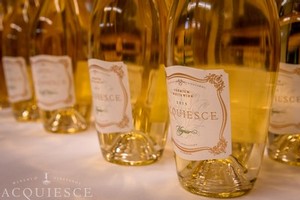The Ageability of White Wines
When we think about aging wines and holding some of our better bottles aside, most of us probably think only in the realm of red wines. But did you know some white wines age beautifully, too? They do!
 We humans have known for a long time—as far back as ancient Greece and Rome—that wine can improve with age. It’s even mentioned in the Book of Luke in the New Testament that old wines are valued over new wines. But over the millennia, we’ve refined our knowledge to knowing not *all* wines age well. Some, say a Beaujolais Nouveau, are best consumed very young. But well-crafted wines—yes, even white wines!—with good acidity and medium to full body can change and improve over the years they spend in the bottle.
We humans have known for a long time—as far back as ancient Greece and Rome—that wine can improve with age. It’s even mentioned in the Book of Luke in the New Testament that old wines are valued over new wines. But over the millennia, we’ve refined our knowledge to knowing not *all* wines age well. Some, say a Beaujolais Nouveau, are best consumed very young. But well-crafted wines—yes, even white wines!—with good acidity and medium to full body can change and improve over the years they spend in the bottle.
Let’s talk about esters.
“Esters are the aromatic, fruity compounds in wine, formed during fermentation, malolactic fermentation (MLF) and ageing. There are many factors that influence the types and quantities of esters present and although all of them are not positive contributors, as a group, they are a major constituent of wine.” (WineLand Media-will include hyperlink in blog)
Esters vary from fruit to fruit—a green apple, for example, is loaded with naturally occurring or endemic esters. But wine grapes have far fewer natural esters. So where do all those complex wine aromas come from? WineLand explains:
“Research has identified 11 different esters in grape juice, but wine can have up to 83; this affects the wine’s flavour and complexity in proportion to their presence. Esters are formed when an acid reacts with alcohol, eliminating a water molecule in the process.”
Acquiesce’s wines never go through MLF, so the esters in our wines happen via fermentation, and (if you have the willpower to cellar them for a few years) AGING!
You Say You Want an Evolution?
And this is where wine gets VERY interesting. While a young bottle of white wine, say our 2018 Viognier, has very up-front fruit flavors and aromas, its sibling that’s a few years older will have grown up. Instead of the intense leading notes and flavors of fruit, you may find those aromas and flavors more complex and layered. The strong fruity esters of youth may give way to esters that hint at honeycomb or a subtle almond flavor. Compare the tasting notes of our 2018 Viognier with its 2015 sibling, which we recently poured for guests at our Acquiesce En Blanc dinner:
“Fields” of lavender, ultra-intense and fragrant, with faint suggestions of peach and exotic/spiced flower notes; firm, medium full body, yet light and airy in the feel. Reminiscent of honeyed tangerine and peach, this wine is crisp and dry, yet round on the palate. Aroma of violets, followed by a long, dry finish.” -2018 Acquiesce Viognier
And after a few years of bottling aging?
“Aromatic suggestions of slate, minerality, stone fruit and dried tea rose petals enhance the delicate mid-palate of Chinese herbs, fennel, and lemongrass, creating a lingering finish.” -2015 Acquiesce Viognier
Granted, these are different wines of different vintages, so the flavor and aroma makeup of the wine can and will vary somewhat from year to year. But our style and approach at Acquiesce has been consistent from the beginning, so while the wines may differ a bit with each vintage, they are still reliably similar. Those extra years in the bottle, however, create greater layers in complexity with the aromas and flavor profile, introducing new tertiary flavors that come on with age (the minerality, the herbiness, the more subtle fruit).
What to Expect With an Aged White Wine.
The first thing you’ll probably notice from a white wine with some bottle age is a change in color. The pale, bright straw color of the new white wine will grow into a slightly deeper gold color. The aromas may change slightly, and there may even be off-aromas initially; don’t be surprised by this, but also don’t let it concern you too much. This is where decanting comes in. Yes, you should consider decanting older white wines, just as you would with a red wine! Those types of aromas should “blow off” (or mostly evaporate) once it’s had a chance to open up a bit. Think of the wine as stretching its legs after being in a cramped position for a long time.
Then comes the fun part; once decanted, you get to discover how that fruity youngster has developed. Where there was bright tangerine before, you may detect hints of honeycomb or candied citron. Where the acids practically danced in the glass in a newly made wine, you may find the acid making its presence known in more subtle ways, along with hints of wet slate or a slight brininess. Take your time with these wines and let them reveal themselves as you sip and savor.
Our first commercial vintage was 2011, so we are only just now able to explore bottle age in Acquiesce wines ourselves, and we’re loving what we’re tasting so far. We are confident that with proper storage (keep away from light and heat), our wines will continue to age beautifully in bottle up to 10 years (and perhaps beyond!).
As difficult as it may be to hold back a few bottles of our bright, lovely wines for aging, we think you’ll love the result as much as we do.